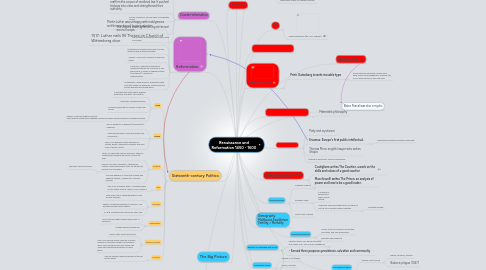
1. Renaissance Worldview. The renaissance began as a adaption of Medieval worldviews and its initial target was as a campaign for medieval Latin.
1.1. Humanists unearthed old Greek and Classical works, looked to a more secular view of society, put the emphasis back on man as an entity
1.2. Humanists perfected a linguistic science called philology, the study of vocabulary and usage.
2. Ambitions of the State
2.1. Chief ambitions were to raise money, make war, feed the court, and do justice
2.2. Justice elevated rulers and kept the peace but attempts at it were largely haphazard.
3. Counter-reformation
3.1. Catholic response to Luther was slow
3.2. The Count of Trent meets under Paul III to reaffirm the corpus of medieval law. It pushed bishops into cities and strengthened their authority.
3.3. Roman Inquisition, Roman Index of Prohibited Books.
3.4. The Jesuits under Ignatius Loyola fanned across Europe.
3.5. The counter-reformation was overall quite successful.
4. Reformation
4.1. Martin Luther was unhappy with indulgences and the practice of buying salvation.
4.2. 1517: Luther nails 95 Theses on Church of Wittenberg door
4.3. Protestanism allowed church folk to marry, stripped away medieval heritage
4.4. Charles V calls Diet of Worms to summon Luther
4.5. Calvinism, a separate Protestanist movement springs up. Calvinism is less hierarchical, is origin of English Puritans ("puritanical"); believes in predestination.
4.6. Anabaptists, a third group of Protestants with very little regard for hierarchy, travelled across Europe and later across the world.
5. The Big Picture
6. Worldviews
7. Sixteenth-century Politics
7.1. Spain
7.1.1. Continent was under partial Spanish hegemony until early 17th century.
7.1.2. Spain was a divided kingdom
7.1.3. Success came with its colonies in the New World.
7.1.4. Charles V split his kingdom and put Spain and the Netherlands together and his successor faced problems of religious division.
7.2. France
7.2.1. War of Religions: Huguenots (Calvinists) vs. Catholics
7.2.2. Saint Bartholomew's Massacre killed many Huguenots
7.2.3. Henri IV of Bourbon enacts the Edict of Nantes, grants Huguenots immunity and says "Paris is worth a mass"
7.3. England
7.3.1. Henry VIII splits the Church and forms Anglican Protestanism because he cannot divorce his wife.
7.3.2. Henry's successor, Elizabeth I, defeats her Catholic older sister Bloody Mary for the throne, and rules for long years.
7.3.2.1. conquers Spanish Armada
7.3.3. Civil War happens in 1642 that unseats and beheads Charles I, leading to a Calvinist republic
7.4. Italy
7.4.1. Italy is not a singular state.; consisted mainly of city-states such as Venice, Milan, Florence
7.5. Germany
7.5.1. Was under rule in Hapsburg lands by Holy Roman Emperor.
7.5.2. Peace of Augsburg enacted by Charles V: "he who holds power holds religion."
7.5.3. In 1618, Germany slips into the 30 Years War
7.6. Netherlands
7.6.1. "low countries" where many traders met; 17 provinces
7.6.2. Fought against Spanish rule
7.7. Ottoman Empire
7.7.1. Muslim state feared by Europe
7.7.2. Had a civil service mainly made up of slaves, children of Christian mothers converted to Islam; the Janissaries were also slaves; the Turks also tolerated the practice of other faiths
7.8. Muscovy
7.8.1. Ivan the Terrible undercuts power of the old boyar nobility
8. Blaise Pascal was also a mystic
9. Medieval Worldview
9.1. 1. Notion of a Divine Plan 2. Great Chain of Being; this thinking traces back to Plato and his followers 3. Dualism: a Platonic idea, spirit, soul, intellect and reason gave shape and nobility to unruly matter. In Christian eyes, our physical bodies incited us to sin. 4. Allegory: reading a material thing to find the higher spiritual or moral meaning behind it. 5. Providence: mere accidents seldom happen 6. Teleology: from Aristotle, all things have a telos, or inherent purpose
10. Skepticism by Montaigne, the inventor of the essay.
10.1. Materialist philosophy
11. The Renaissance Man: one who is learned in all the arts and sciences e.g. Da Vinci
12. Art
12.1. Linear perspective (Da Vinci, Raphael)
13. Religion: an everyday part of life
13.1. Christian ethics: self-denial like Christ "put others first", love of one's neighbours
13.1.1. New node
13.2. - Served three purposes providence, salvation and community
14. Families and Friends
14.1. Family: a unit of economic production, education, and self-governance
14.2. Property was a bedrock
15. The Honour Code:
15.1. Be proud, not humble.
15.2. Be rich, not poor.
15.3. At conflict with religious views.
16. Demography: Malthusian Equilibrium Fertility = Mortality
17. A Dangerous World
17.1. Disease: fast-moving
17.1.1. Typhus, smallpox, typhoid
17.1.2. Bubonic plague (1347)
17.2. Famine
17.3. Violence and chaotic wars Banditry
18. Social hierarchy
18.1. Inequality is good
18.1.1. New node
18.2. Feudalist views
18.2.1. A method of governing in which land is central
18.2.2. Lords held fiefs, had power to tax, to judge, to run the local markets; power inherited
18.2.2.1. Heriditary powers
18.3. Great chain of being
19. A Revolution in the Military
19.1. Medieval Times
19.1.1. Armoured knights on horseback
19.1.2. Stone Castle
19.2. Gunpowder changed medieval times
19.2.1. Cannon was invented
19.3. In response to the cannon: star-shaped, bastioned fortresses were created
19.3.1. Kingston, Quebec, Louisburg, etc
20. Renaissance
20.1. Print: Gutenberg invents movable type
20.1.1. Books become affordable, vernacular is used, news and propaganda is fostered; still, only a small portion of men can read.
21. High Renaissance in Rome: the patronage moves from Florence to Rome
21.1. Castiglione writes The Courtier, a work on the skills and values of a good courtier
21.2. Macchiavelli writes The Prince, an analysis of power and how to be a good leader.
22. Northern Renaissance
22.1. Piety and mysticism.
22.2. Erasmus: Europe's first public intellectual.
22.2.1. Erasmianism blended Humanism with piety.
